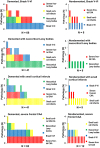Population-based analysis of pathological correlates of dementia in the oldest old
- PMID: 28275649
- PMCID: PMC5338150
- DOI: 10.1002/acn3.389
Population-based analysis of pathological correlates of dementia in the oldest old
Abstract
Objective: The aim of this study was to analyze brain pathologies which cause dementia in the oldest old population.
Methods: All 601 persons aged ≥85 years living in the city of Vantaa (Finland), on April 1st, 1991 formed the study population of the Vantaa85 + study, 300 of whom were autopsied during follow-up (79.5% females, mean age-at-death 92 ± 3.7 years). Alzheimer's disease (AD) pathology (tau and beta-amyloid [Aβ]), cerebral amyloid angiopathy (CAA) and Lewy-related pathologies were analyzed. Brain infarcts were categorized by size (<2 mm, 2-15 mm, >15 mm) and by location. Brain hemorrhages were classified as microscopic (<2 mm) and macroscopic.
Results: 195/300 (65%) were demented. 194/195 (99%) of the demented had at least one neuropathology. Three independent contributors to dementia were identified: AD-type tau-pathology (Braak stage V-VI), neocortical Lewy-related pathology, and cortical anterior 2-15 mm infarcts. These were found in 34%, 21%, and 21% of the demented, respectively, with the multivariate odds ratios (OR) for dementia 5.5, 4.5, and 3.4. Factor analysis investigating the relationships between different pathologies identified three separate factors: (1) AD-spectrum, which included neurofibrillary tau, Aβ plaque, and neocortical Lewy-related pathologies and CAA (2) >2 mm cortical and subcortical infarcts, and (3) <2 mm cortical microinfarcts and microhemorrhages. Multipathology was common and increased the risk of dementia significantly.
Interpretation: These results indicate that AD-type neurodegenerative processes play the most prominent role in twilight cognitive decline. The high prevalence of both neurodegenerative and vascular pathologies indicates that multiple preventive and therapeutic approaches are needed to protect the brains of the oldest old.
Figures


References
-
- Wimo A, Jonsson L, Bond J, et al. Alzheimer Disease International. The worldwide economic impact of dementia 2010. Alzheimers Dement 2013;9:1–11e3. - PubMed
-
- Thies W, Bleiler L; Alzheimer's Association . 2013 Alzheimer's disease facts and figures. Alzheimers Dement 2013;9:208–245. - PubMed
-
- Snowdon DA, Greiner LH, Mortimer JA, et al. Brain infarction and the clinical expression of alzheimer disease. the nun study. JAMA 1997;277:813–817. - PubMed
-
- Massoud F, Devi G, Stern Y, et al. A clinicopathological comparison of community‐based and clinic‐based cohorts of patients with dementia. Arch Neurol 1999;56:1368–1373. - PubMed
LinkOut - more resources
Full Text Sources
Other Literature Sources
Miscellaneous

